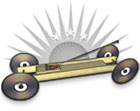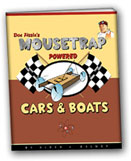Mousetrap Cars: Friction
Without friction your mousetrap vehicle would travel forever, learn how to conquer friction. You cannot build a winning mousetrap racer until you know the basics.
Perhaps the second most important concept to understand when building a mousetrap powered car is the concept of friction. In the perfect universe where there was no friction a mousetrap car would travel forever or until it hits something. But we do not live in a perfect universe and friction is a real force that acts against the motion of all moving objects. Friction occurs anytime two surfaces slip, slide, touch, and/or move against one another. There are two basic types of friction, surface friction, and fluid friction. In some situations fluid friction is called air resistance. A ball thrown through the air is affected by fluid friction and a block sliding on a table is mainly affected by surface friction.
identify friction: friction is the force that acts against the motion of every moving object. study your vehicle to identify points of friction and where friction can be controlled.
Surface Friction
Surface friction occurs any time two surfaces touch and/or rub against one another. The cause of surface friction is mutual contact of microscopic irregularities that exists on all surfaces. These microscopic irregularities act like little road blocks or obstructions to motion. Even surfaces that appear to be perfectly smooth have irregularities when viewed under a microscope. The amount of surface friction acting between two object depends on the kinds of material from which the two surfaces are made and how hard the two surfaces are pressed together. A wooden block placed on a sheet of glass will have an easier time sliding than when the same block is placed on a concrete sidewalk. If a mass is now placed on top of the wooden block there will be more weight or force pressing the block onto the other surface making it even more difficult for the block to slide. As any two surfaces are pressed harder and harder together their irregularities will require more and more force to overcome.
bonus tip: microscopic irregularities act like small mountains and valleys that cause objects to resist sliding.
Surface friction can be decreased by smoothing out the irregularities that exists between two surfaces. The smoother two surfaces can be made the less friction that will exists between them, to a point. One might think that if you could make two surface perfectly smooth there would be no friction at all. But on a microscopic scale when any two surfaces become perfectly smooth there is the potential for bonding on an atomic level where molecules and atoms now interact with one another. So we can never totally eliminate surface friction but we can learn how to decrease it as much as possible.
bonus tip: two perfectly smooth surfaces that touch one another can bond on an atomic level.
One last important concept about surface friction, it will always take more force to start an object sliding than to keep the object sliding; this is because you first have to brake through the road blocks or irregularities of the two surfaces. Once you brake through the irregularities, the inertia or the momentum of the moving object will continue to help it continue to brake through the irregularities as long as enough energy is put back into the system to keep the block sliding. This concept also shows that surface friction is unaffected by speed. Surface friction is always the minimum force required to overcome the irregularities regardless of how fast the object is sliding.
Building Your Mousetrap Car
Your number one goal when building a mousetrap car is to design a vehicle that has the lowest rate of energy loss to friction as possible; in other words, design a friction-less vehicle. You can never eliminate friction but you can decrease the amount of friction acting against a vehicles motion in order to extend its travel distance and/or speed. Evaluate every moving component on your vehicle and try to decrease the total amount of friction at each point. As a general rule of thumb, the more moving components that a machine has, the greater the total force of friction, simplify your design.
Axle Points
The number one point of friction on any mousetrap car is where the axle system comes in contact with the frame of the vehicle. In most cases an axle will be in direct contact with the frame and there is a lot that can be done to decrease the friction at this contact point. Test spin your mousetrap racers wheels in order to see how friction-free they spin. If the wheels stop spinning fairly quickly then you will need to find ways to reduce the axle friction. Try using graphite powder or even replacing bushings with ball bearings.
Friction at the axle points depends on:
- The diameter of the axle
- The pressure on the axle by the bearing
- The types of materials used for the axle and bearing
bearings: The number one point of friction on any mousetrap car is always at the bearings. Find ways to reduces the friction at the bearing points.
Axle Diameter
Larger diameter axles have greater friction when compared to the same axle of a smaller diameter. With a smaller diameter axle the force of friction is applied closer to the center of rotation and applies less torque than a larger diameter axle. Try to select axles that are equal to or less than 3/16 inch in diameter.
Bearing Pressure
Lighter mousetrap cars will have less weight pushing down on the bearings so always select lightweight building materials when constructing your mousetrap vehicle. Also make sure that your mousetrap vehicle's bushings do not pinch on the axle, a small amount of play is a good thing to have in a bushing system.
Materials
Some materials have less friction when used together than other materials. The friction at a bearing point will depend on the materials you select for the axle and the bushing. There are many different materials that you can match-up when making a bushing system but some times it is best to have a chart of coefficients of friction in order to help determine which of the materials that are available to use will work the best together.
Air Resistance
Imagine you are in a pool of water, you will find that it is easy to walk around in the water but once you try moving fast or even running in the water you immediately feel the resistance of the water pushing against your motion; this is the same experience a mousetrap vehicle will have as it tries to push it's way through the air. The faster the mousetrap vehicle moves the more the air will push back against the vehicle's motion. Design your mousetrap racer so that it can slice through the air with the least amount of resistance; design your vehicle to be aerodynamic. Try sanding and painting wood frames in order to cut down on the air resistance. Slow moving mousetrap vehicles will experience less friction than faster moving vehicles. If your mouse trap challenge is for maximum distance, then design you mousetrap car to be slow moving; this can be achieved by adjusting the vehicle's gearing.
Factors that effect the air resistance:
- the speed of the vehicle
- the shape of the vehicle
air resistance: design your mousetrap car to be aerodynamic in order to decrease the force of friction acting against it's motion.
*Can't find what you're looking for? Ask Doc Fizzix »




